 Last summer at my annual check-up, I found out that my blood cholesterol level was HIGH – it was over 6.2 mmol / L.
Last summer at my annual check-up, I found out that my blood cholesterol level was HIGH – it was over 6.2 mmol / L.
WHAT?! Honestly, I was shocked.
I eat well and have been active all my life, so what was going on?
Could it be stress?
Admittedly, I was going through a very stressful period, lasting months. According to the Heart and Stroke Foundation, stress can affect our heart health and prolonged or chronic stress (lasting months to years) can increase blood cholesterol and blood pressure.
Studies from the Medicine journal and Scandinavian Journal of Public Health found that both psychological stress and job stress can increase blood triglyceride levels as well as the “bad” LDL (Low Density Lipoprotein) cholesterol.
In addition to stress, I have non-modifiable risk factors for high blood cholesterol – I’m female, over the age of 50 and have a family history of high blood cholesterol. Interestingly, research shows that total cholesterol levels peak in women at age 55-65.
So I did these 13 things to lower my blood cholesterol
I focused on doable, daily, dietary and lifestyle actions that were simple and sustainable. I followed healthy eating principles from the Portfolio Diet, recommended by the Canadian Cardiovascular Society.
1. I consistently ate oatmeal for breakfast. Oatmeal is a whole grain and contains a special type of soluble fibre called beta-glucan which is known to reduce blood cholesterol levels. According to Health Canada, 3 grams of beta glucan fibre per day can lower total and LDL cholesterol by about 5-8%. A serving of oatmeal (1/3 cup) contains 40% of the fibre amount needed. Bonus – I added a couple of tablespoons of All Bran Buds cereal for pysllium which is another cholesterol-lowering fibre. Get my Hearty Morning Oatmeal recipe!
2. I swapped out 2% Greek yogurt for 0%. Even though 2% milk fat is considered “low fat”, I wanted to reduce my saturated fat intake even more since this type of fat can raise blood cholesterol levels. With 0% milk fat products, there is zero saturated fat. I also cut back on my portions of cheese (a source of saturated fat). Lower fat cheese just doesn’t do it for me, so I prefer to eat regular cheese less often and in smaller amounts. And I reduced my butter intake, which I really only used on freshly baked bread.
3. I ate barley on repeat. Barley is another whole grain which contains that wonderful cholesterol-lowering beta-glucan fibre. My favourite way to eat barley was in Beef Barley Soup and Barley & Butternut Squash Risotto.
4. I made more dinners with plant-based proteins. I aimed to make at least two plant-based dinners a week. These included tofu stir-fries, baked tofu, edamame beans and lentil bolognese. Compared to animal-based proteins, plant-based proteins are lower in saturated fat plus they can add extra fibre.
5. I ate nuts and seeds every day. I used to snack on nuts in the afternoon. But whenever my work day got too busy, I’d forget about my snack. So I added nuts and seeds to my morning oatmeal so that I didn’t miss out on the heart healthy fats found in these foods. Bonus: nuts and seeds offer plant-based protein.
6. I ate fish as least once or twice a week. Salmon is my favourite for heart healthy omega-3 fats. I tried a Maple-Pistachio Crusted Salmon recipe and made a few batches of Salmon Chowder which uses canned salmon! Sometimes, canned sardines with crackers were in the rotation for lunch.
7. I ate leafy greens every day. I ate a lot of veggies already, but paid extra attention to leafy green veggies. Not only is this important for my brain and eye health, but also for heart healthy nutrients like magnesium. My go-to greens were Sautéed Mushroom & Spinach Salad, and Beet Salad with Goat Cheese and Arugula.
8. I enjoyed fruit for dessert…most of the time! I love dessert, especially when it’s home-made! Most of the time, I opted for fresh berries or a small piece of dark chocolate. I didn’t deprive myself of rich desserts though – I just saved them for special occasions and enjoyed a smaller portion.
9. I built in daily physical activity. Using my home exercise equipment, I was active daily. And I’d walk the dog at least once or twice every day. On vacations, I purposely planned cycling and hiking excursions. To dial up the intensity and variety of my workouts, I joined a gym. I created a great training routine combining cardio, strength, balance and flexibility.
10. I prioritized sleep. Sleep was key to my stress management. My sleep routine involved quiet time, reading, stretching and deep breathing. I aimed to get at least 7-8 hours of sleep each night.
11. I took time off from social media. While fun and entertaining, social media can also be draining and damaging to mental health. When I started comparing myself to the images I was seeing, I knew it was time to take a break. Now, I set limits on what I watch and how often I even go on social media.
12. I listened to more audio books. I love learning and always looked forward to my “me time” with a good audio book. These days, I’m learning a new language!
13. I went outside every day. No matter what the weather, I stepped outside, often with puppy at my side. Fresh air and a good sweat are such great stress busters!
And now, 6 months later…
My total blood cholesterol has dropped 12% and is in a good range. I’m still going strong with each of the 13 actions above.
There are many risk factors to high blood cholesterol, including diet, physical activity, stress, age, gender, family history, smoking and alcohol. If you’re trying to make changes, ask yourself what actions you can realistically do – and more importantly – maintain over time. Are there any ideas above that you can try? Every small action adds up! For more information, check out the Heart and Stroke Foundation.
Note: This information is for educational purposes and not intended to replace the medications and / or recommendations advised by your health care professional. My results may be different from your’s. Please reach out to a dietitian for personalized dietary advice.
 It’s Heart Month and our food choices can have a big impact on our heart health.
It’s Heart Month and our food choices can have a big impact on our heart health. Alright, we all know that eating fruits and veggies are good for you. In fact, eating at least 5 servings of fruits and veggies every day can lower your risk for health problems such as heart disease and type 2 diabetes.
Alright, we all know that eating fruits and veggies are good for you. In fact, eating at least 5 servings of fruits and veggies every day can lower your risk for health problems such as heart disease and type 2 diabetes.















